Do you have a pain-free, healthy writing space?
We all know that spending too much time in the wrong chair can set you up for a lot of pain.
The answer has to be finding the right chair, right? And there is no shortage of options out there.
The gurus of ergonomics have pulled out all the stops to design top-of-the-line, super expensive works of art that support us from every angle and do everything but suspend us in a weightless zone of space so we can work for hours upon hours in complete comfort and get up ready to run the Boston Marathon.
All we have to do is just save up enough money to invest in one of these beauties and viola, no more back, neck, hip, and knee pain. Writing bliss as it was meant to be.
Um, yeah.
Pain-Free Healthy Writing Space—Is It About the Chair?
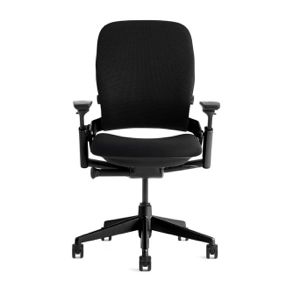 Why, there’s the award-winning Steelcase Leap Ergonomic Office Chair (at left) with “revolutionary LiveBack technology” sure to provide you with superior support “in places that need it most.”
Why, there’s the award-winning Steelcase Leap Ergonomic Office Chair (at left) with “revolutionary LiveBack technology” sure to provide you with superior support “in places that need it most.”
And it’s only $942 on sale.
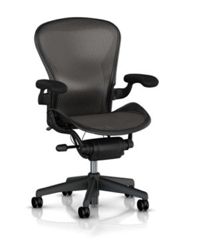 If that’s a bit too much for you to swallow you can go for the popular Aeron Chair (at right). It has a breathable membrane that “eliminates pressure points” while supporting your back at the base of the spine. You pay only $645 on sale.
If that’s a bit too much for you to swallow you can go for the popular Aeron Chair (at right). It has a breathable membrane that “eliminates pressure points” while supporting your back at the base of the spine. You pay only $645 on sale.
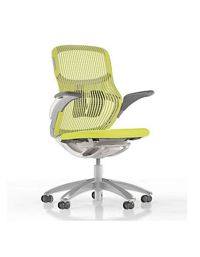 If you want good looks along with your support maybe this bright yellow Generation Chair by Knoll is for you. It’s got a sleek design and “advanced ergonomics” that support you in three different sitting postures.
If you want good looks along with your support maybe this bright yellow Generation Chair by Knoll is for you. It’s got a sleek design and “advanced ergonomics” that support you in three different sitting postures.
Again, you’ll pay close to $1,000 for it, but hey, it’s worth it if it keeps you pain-free, right?
Before you go spending your hard-earned cash on these or other similarly high-priced ergonomic wonders, let me give you something to think about: the truth is that what a writer needs—especially a hard working writer who’s at the computer for several hours a day—is not just one chair, but three or more.
Here’s why, and what really matters when it comes to these tools of the writer’s trade.
What Just a Few Hours of Sitting Does to You
Here’s the basic truth: What causes us pain, first and foremost, is staying in one position.
The body is made to move, which is why our modern-day devotion to technology is causing us so many problems, including all types of pain, weight gain, brain fog, and all the related diseases caused by inactivity.
Sitting, particularly for more than a short time without active breaks, causes unhealthy changes in the body at every level.
According to Joyce Hanna, Associate Director, Stanford Health Improvement Program, studies have shown that when participants stay in one position for too long, the digestive enzyme that breaks down fat is lowered while insulin resistance rises.
Just 3 Hours of Sitting Can Lead to Back Pain
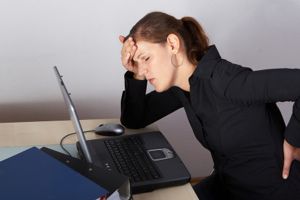 Just three hours of uninterrupted sitting can also disrupt vascular function—a 33 percent reduction in the ability of arteries to dilate according to one study.
Just three hours of uninterrupted sitting can also disrupt vascular function—a 33 percent reduction in the ability of arteries to dilate according to one study.
This level of dysfunction is comparable to what happens in people with cardiovascular disease. It’s why people who sit for too long are at risk for vascular problems like blood clots, varicose veins, and edema (swollen ankles and feet).
And these changes are just the beginning.
“Sitting for long periods of time — when you don’t stand up, don’t move at all — tends to cause changes physiologically within your muscles,” says New York Times physical education columnist Gretchen Reynolds. “You stop breaking up fat in your bloodstream, you start getting accumulations of fat … in your liver, your heart and your brain. You get sleepy. You gain weight. You basically are much less healthy than if you’re moving.”
Pain-Free Healthy Writing Space—It’s About the Activity
Our physical selves need gravity, resistance, and work to be at their best. Joan Vernikos, Ph.D. and medical research scientist, notes in her book Sitting Kills, Moving Heals, that keeping participants immobile and resting caused the same problems that astronauts experience in a weightless environment, namely, deterioration of the muscles and bones and rapid aging.
In her description for the book, Vernikos explains that those who work at desks, watch TV, and move far too little, experience more illnesses such as obesity, diabetes, heart disease, osteoporosis, muscle wasting and arthritis, balance and coordination problems, poor sleep, and lack of stamina.
“These disorders, once believed to be consequences of aging, are now appearing much earlier in life—even in children, who are increasingly glued to different forms of sedentary electronic entertainment.”
PainScience writer Paul Ingraham agrees, stating that chronic inactivity causes “marked degeneration of virtually every measure of physical fitness,” including reflex degeneration, tendon rot, and vulnerability to chronic pain.
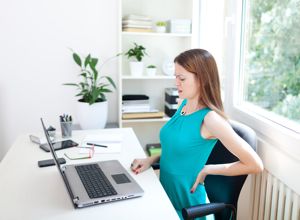 Sitting Too Much Translates to Pain, No Matter What Chair You’re Using
Sitting Too Much Translates to Pain, No Matter What Chair You’re Using
Studies show that when resting for too long, muscles stop producing substances we need for health, including genes involved in blood circulation, blood clotting and more.
It also puts extra pressure on the spine, and the way most of us sit when working, pressure on the neck and hips as well.
Kelly McGonigal, Ph.D., a health psychologist at Stanford University, stated in Mashable article that sitting is bad news for the back:
“When you sit, you distort the natural curve of the spine, which means your back muscles have to do something to hold your back in shape because you’re no longer using the natural curves of the spine to lift yourself up against gravity.”
Sitting rotates the pelvis backwards, which puts pressure on the vertebrae in the lower back while causing the shoulders to curve forward, a posture that when maintained for more than a short time, increases risk of muscle and joint pain.
The leg muscles get weak and flabby, making them less likely to support joints like the knee and hip joints, again, resulting in pain.
Pain-Free Healthy Writing Space: Your Muscles Are Tightening!
The lack of activity particularly affects the gluteus muscles (in your backside), putting you at risk for piriformis syndrome, a condition that causes pain in the buttocks that can radiate down the legs. Sciatica, anyone? Weak glutes also lead to tight hip flexors, which again, can lead to back pain.
 All that sitting also compresses nerves, and can cause nerve pain just about anywhere in the body, but is particularly common in the sciatic nerve, and in nerves in the neck, legs, elbows, and wrists.
All that sitting also compresses nerves, and can cause nerve pain just about anywhere in the body, but is particularly common in the sciatic nerve, and in nerves in the neck, legs, elbows, and wrists.
The nerves are also affected by the reduced blood flow, which is why you may feel a tingling in your legs and feet or other areas of the body when standing up.
If you experience stress while you’re sitting—a common experience—you can actually shorten the muscles in your neck, back, shoulders, and more. Steven Wolf, associate professor in the department of physical and rehabilitative medicine at Emory University School of Medicine in Atlanta, told the New York Times:
”People in tense, sedentary jobs are particularly prone to a chronic shortening of the muscles. The buildup continues each day as the tensions repeat. As time goes on, their neck and shoulder muscles get shorter and shorter.”
That, of course, translates to pain, including headaches, neck pain, jaw pain, and shoulder pain. Tense muscles also constrict blood flow, causing a buildup of waste and toxic products in the same areas, increasing pain sensations.
 Pain-Free Healthy Writing Space—It Affects Your Brain Too
Pain-Free Healthy Writing Space—It Affects Your Brain Too
It’s not just the body that suffers from lots of sitting. Your brain, too, experiences unhealthy changes.
The reduced blood flow affects your thinking, as the brain gets less oxygen than it needs to stay sharp. Sitting all day also produces mental fatigue—a bad thing if you are hoping to write when you get home from work.
If you sit with poor posture (as most of us do despite our best efforts), you may also be causing your own bad mood without even knowing it. In a 2010 study, researchers found that when depressed, participants were more likely to slouch and drop their heads forward than when they were experiencing better moods.
Another study showed that those who sat upright with better posture reported higher self-esteem and better mood than those who sat slumped.
In a study of over 3,000 government workers, those that spent more than six hours a day sitting down were more likely to experience psychological distress than those who sat fewer than three hours—and that was true no matter how much exercise they got outside of the seated times.
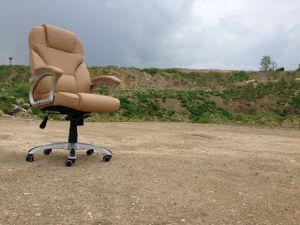 Even the Most Advanced Chair Offers an Empty Promise
Even the Most Advanced Chair Offers an Empty Promise
Ergonomic companies try to convince us that their advanced designs will make it all better. But at most, their products can give us a few more minutes before the pain, fatigue, depression, muscle wasting, circulatory problems, and more settle in.
The only real answer to all these unhealthy changes is to get up more, move more, and change positions more.
Yes, a quality ergonomic chair will support you comfortably for longer than a cheap aluminum fold-up. But the point is that the chair can go only so far in keeping you healthy and pain-free. The rest is up to you, so it’s time to add some variety to your workspace.
A Pain-Free Healthy Writing Space Invites Movement
I’d suggest you revamp your writing office or nook. Instead of just a desk and a chair, it’s time to inspire movement. Here are some tips for things you can add that will encourage you to get up and give your body a break:
- A timer set to go off every 30 minutes
- Jump rope
- Pedometer
- Small glass for water so you have to refill it often
- Rebounder (small trampoline) inviting you to jump up and down now
- Adjustments so you can turn your sit-down desk into a standing desk and vice-versa
- A music player of some sort—so you can turn on the tunes and dance
In addition to these, it’s time to add another chair or two. The point is to create an atmosphere that encourages you to get up, move, change positions, and then stay there for only a limited time before you get up and move again.
Study after study shows that breaking up the sitting—even with short, five-minute increments—can help counteract the effect the sitting has on your body and mind.
I’m talking about a different arrangement than most writers are used to. And trust me—you can adapt to it so that you can continue your line of thinking even with the changes.
Fix Up Your Writing Space So You Can Shift Positions
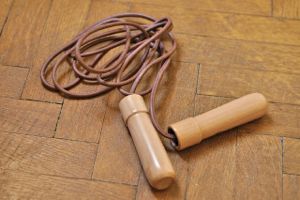 I’ve gravitated toward this sort of a workspace myself, and it didn’t cost any money.
I’ve gravitated toward this sort of a workspace myself, and it didn’t cost any money.
Instead of chaining myself to my desktop for eight hours a day, I now change it up frequently.
I work in my old favorite chair on the desktop for a short time, then use an old file box to convert my regular desk into a standing desk for a short time, and then go back to sitting if I need to.
When I switch over to using my notebook computer, I have a reclining easy chair nearby, and across the room, an old tall stereo on which I can place my notebook computer so I can work on it standing up.
I also have a TV-tray that with the old file box, converts to another standing desk if I want to position myself to look out the window.
At any point in the day, you can find me at one of these various “stations,” or taking my iPad out on a walk to read and study on the way. I have a jump rope ready and waiting under the printer, and I’m looking forward to the day when I can purchase a Rebounder to add into the mix!
What Will Your Pain-Free Healthy Writing Space Look Like?
You can create your workspace any way you like, but choose options that will change how you position your body. Maybe one of your chairs is an exercise ball, or a beanbag. Perhaps another reclines, or rocks. Maybe one of your chairs is outside, or one is super cushiony and the other is firmer.
The idea is not to waste a lot of money on furniture, but to find ways to invite your body to move and change while you work.
If you have only one chair, and there’s nowhere else to sit, you’re naturally going to be inclined to stay in that one chair. Don’t be surprised if that leads to you using more aspirin, at the very least.
We’ve thought up until now that the solution was to design the perfect chair so that we could sit forever and be fine, but this is an impossible goal. We’re not built this way.
It’s time to change how we’re approaching the issue. Rather than simply create an ergonomically friendly workspace, we must create an area that invites, encourages, and inspires us to move, as that is what will keep us healthy, happy, and at our creative best.
Have you set up your writing workspace to be more movement friendly?
Sources
Bey, L., & Hamilton, M. T. (2003). Suppression of skeletal muscle lipoprotein lipase activity during physical inactivity: a molecular reason to maintain daily low-intensity activity. The Journal of Physiology, 551(2), 673-682. Retrieved from https://www.ncbi.nlm.nih.gov/pmc/articles/PMC2343229/
Canales, J. Z., Cordás, T. A., Fiquer, J. T., Cavalcante, A. F., & Moreno, R. A. (2010). Posture and body image in individuals with major depressive disorder: a controlled study. Revista Brasileira de Psiquiatria, 32(4), 375-380. Retrieved from https://www.ncbi.nlm.nih.gov/pubmed/21308258
Goleman, D., & Bennett-Goleman, T. (1986, September 28). RELIEVING STRESS – MIND OVER MUSCLE – NYTimes.com. Retrieved from http://www.nytimes.com/1986/09/28/magazine/relieving-stress-mind-over-muscle.html?pagewanted=all
Hannah, J. (2010, July). Stanford BeWell. Retrieved from http://web.stanford.edu/group/bewell/cgi-bin/bewell-wp/sit-too-much/
Kilpatrick, M., Sanderson, K., Blizzard, L., Teale, B., & Venn, A. (2013). Cross-sectional associations between sitting at work and psychological distress: Reducing sitting time may benefit mental health. Mental Health and Physical Activity, 6(2), 103-109. Retrieved from http://www.sciencedirect.com/science/article/pii/S1755296613000252
Marturana, A. (2016, February 5). This Is What Sitting All Day Does To Your Butt | SELF. Retrieved from http://www.self.com/story/this-is-what-sitting-all-day-does-to-your-butt
McManus, A. M., Ainslie, P. N., Green, D. J., Simair, R. G., Smith, K., & Lewis, N. (2015). Impact of prolonged sitting on vascular function in young girls. Experimental Physiology, 100(11), 1379-1387. Retrieved from http://onlinelibrary.wiley.com/doi/10.1113/EP085355/abstract
Nair, S., Sagar, M., Sollers, J., Consedine, N., & Broadbent, E. (2015). Do slumped and upright postures affect stress responses? A randomized trial. Health Psychology, 34(6), 632-641. Retrieved from https://www.ncbi.nlm.nih.gov/pubmed/25222091
Pan, J. (2012, June 18). Why Sitting Too Much Is Dangerous. Retrieved from http://mashable.com/2012/06/18/too-much-sitting/#dq3L15Xo9ZqY
Stand Up, Walk Around, Even Just For ’20 Minutes’ : NPR. (2012, May 9). Retrieved from http://www.npr.org/2012/05/09/152336802/stand-up-walk-around-even-just-for-20-minutes
Vernikos, J. (2011, December). Sitting Kills, Moving Heals. Retrieved from http://www.joanvernikos.com/sitting-kills-moving-heals-media-kit-v2.pdf

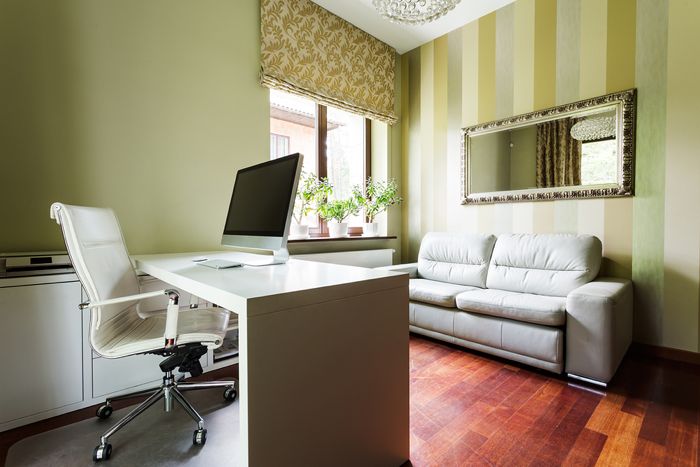
I can’t tell you how timely this is for me, Colleen! I’ve needed a new chair for a while. But I literally hate to shop. You’ve made it easy for me! Thank you!
Oh awesome. I want to see what you get!
Yes! Great article, thanks Colleen. I also switch to sitting on a huge, inflated exercise ball at times. It allows me to move around, balance myself, wiggle, move my hips in a circle, — all good for staying alert, flexible and creative. For more rote kind of writing I sometimes stand. But for the creative stuff, it really does help to settle into a chair comfortably, yet alertly. There’s a good, short TED talk on posture. She reminds us that the most important body part to position properly is our pelvis. Everything else aligns on top of it. Here’s the name of the video: Find your primal posture and sit without back pain: Esther Gokhale at TEDxStanford
I’ve wondered about those exercise balls, Ulrike. Glad it works for you. Yes, posture is important no doubt. Thanks for the recommendation! We also have a great post on that from a harpist here: http://www.writingandwellness.com/2017/03/13/harpist-shares-secrets-on-back-saving-good-posture/
Not sure I have room for multiple chairs, but you make a lot of great points. I got a decent mesh-back chair on sale that has served me well. The adjustable arms reduce some of the slouching. I learned from my kids not to sit so still all the time. You can change positions in the chair too.
Most of the pictures show laptops which also allow you to sit in various positions and places. But yes, I have to learn to break up my computer time more. Thanks.
Good luck with it, David. I’m sure the kids do help! :O)
Here;s another helpful tool, Colleen. I have a couple of Relaxo-Bak butt buckets, one for my downstairs easy chair and one for my office chair. They help protect me from the lower back and hip pain I get from sinking into comfy chairs or slumping at the computer. These helpful aids are lots cheaper and they do work for me. https://www.relaxobak.com/products/original-butt-bucket-orthopedic-comfort-seat/
Thanks for the recommendation, Pat! Much appreciated. I’ll have to check these out. :O)